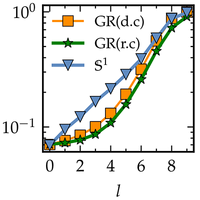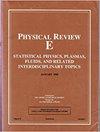弱几何耦合网络的重正化
IF 2.4
3区 物理与天体物理
Q1 Mathematics
引用次数: 0
摘要
重正化群对于理解包括复杂网络在内的各种尺度的系统至关重要。通过网络几何对网络进行重正化是基础方法之一,在网络几何框架中,网络拓扑结构基于节点在隐藏度量空间中的位置。然而,目前的方法假定几何耦合是强耦合,忽略了许多真实网络中的弱耦合。本文将重正化扩展到弱几何耦合,表明几何信息对于保持自相似性至关重要。我们的结果强调了几何效应对网络拓扑的重要性,即使与底层空间的耦合很弱。本文章由计算机程序翻译,如有差异,请以英文原文为准。

Renormalization of networks with weak geometric coupling
The renormalization group is crucial for understanding systems across scales, including complex networks. Renormalizing networks via network geometry, a framework in which their topology is based on the location of nodes in a hidden metric space, is one of the foundational approaches. However, the current methods assume that the geometric coupling is strong, neglecting weak coupling in many real networks. This paper extends renormalization to weak geometric coupling, showing that geometric information is essential to preserve self-similarity. Our results underline the importance of geometric effects on network topology even when the coupling to the underlying space is weak.
求助全文
通过发布文献求助,成功后即可免费获取论文全文。
去求助
来源期刊

Physical review. E
物理-物理:流体与等离子体
CiteScore
4.60
自引率
16.70%
发文量
0
审稿时长
3.3 months
期刊介绍:
Physical Review E (PRE), broad and interdisciplinary in scope, focuses on collective phenomena of many-body systems, with statistical physics and nonlinear dynamics as the central themes of the journal. Physical Review E publishes recent developments in biological and soft matter physics including granular materials, colloids, complex fluids, liquid crystals, and polymers. The journal covers fluid dynamics and plasma physics and includes sections on computational and interdisciplinary physics, for example, complex networks.
 求助内容:
求助内容: 应助结果提醒方式:
应助结果提醒方式:


